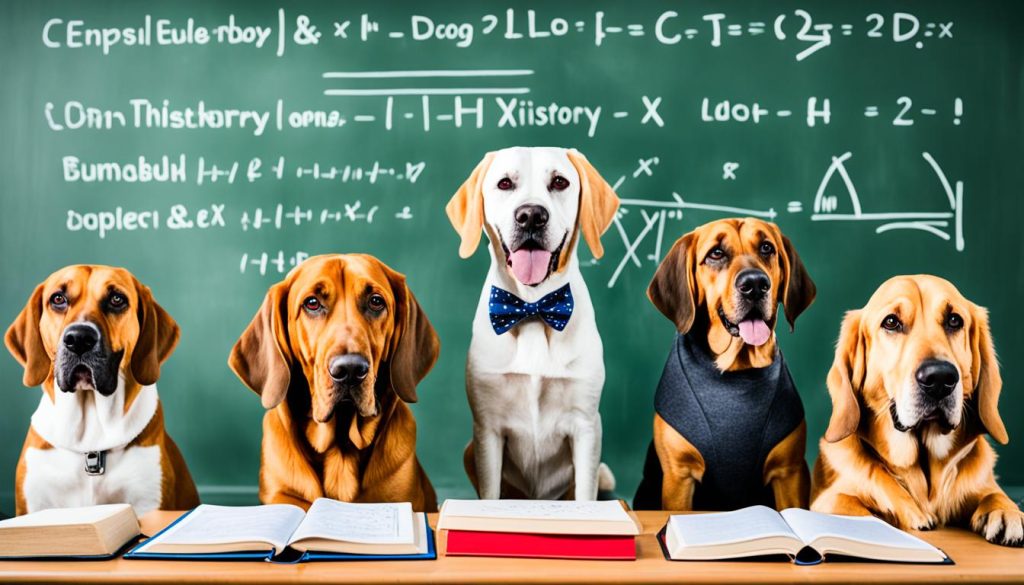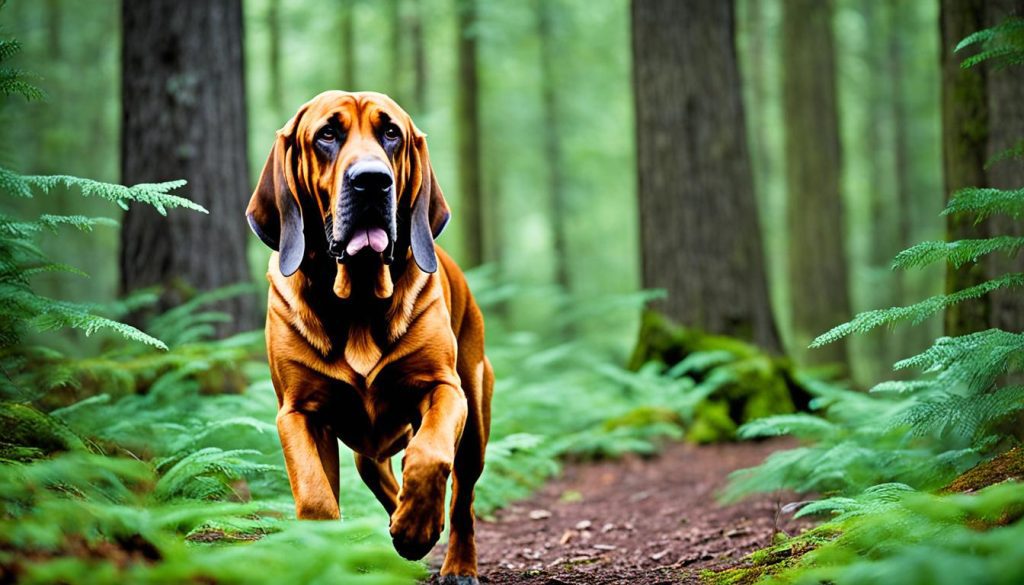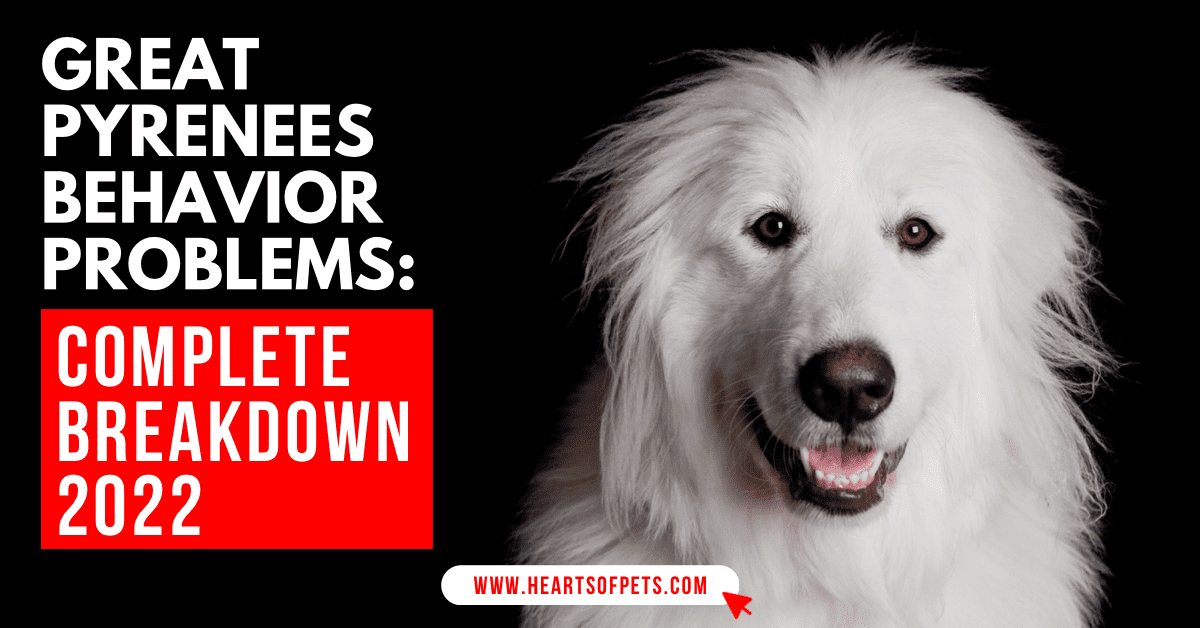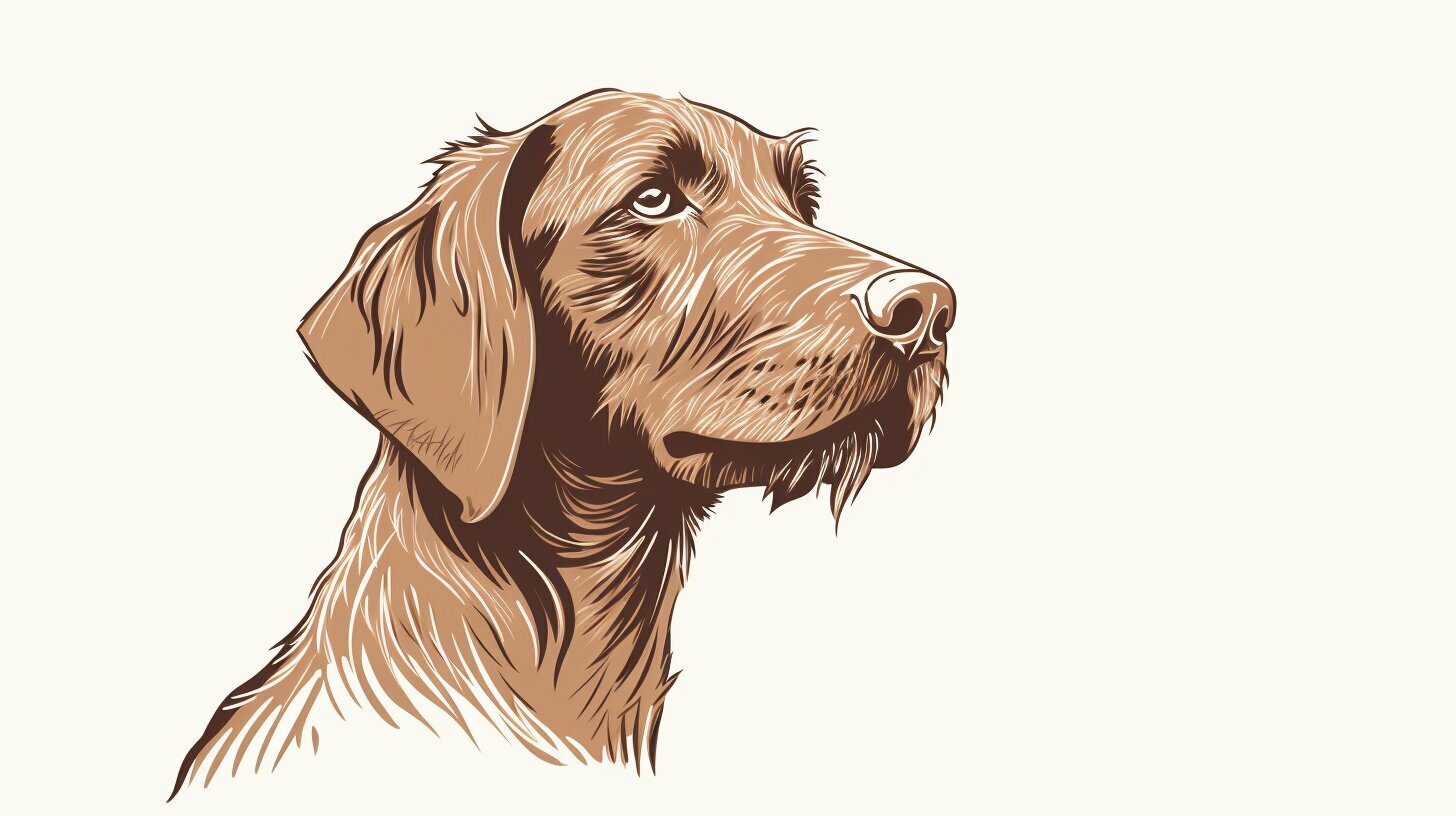When it comes to canine intelligence, there are various factors to consider. For Bloodhounds, their exceptional tracking abilities are a testament to their intelligence. While they may not excel in traditional obedience training, Bloodhounds possess unique breed characteristics that make them highly intelligent in their own right.
Bloodhounds are renowned for their acute sense of smell and their ability to follow scent trails over long distances. This specialized skill is a clear reflection of their intelligence, as they possess a unique set of traits that enable them to excel in their field.
Understanding the intelligence of Bloodhounds and how it applies specifically to their breed is key to fully appreciating their abilities. Let’s delve deeper into the world of canine intelligence and explore what makes Bloodhounds so remarkably smart.
Are Bloodhounds Smart
- Bloodhounds possess exceptional tracking abilities, showcasing their intelligence in specialized tasks.
- Their acute sense of smell and ability to follow scent trails over long distances reflect their intelligence.
- Canine intelligence goes beyond traditional obedience training and encompasses a range of specialized skills.
- Bloodhounds may not rank highly in traditional intelligence tests but excel within their specific domain.
- Their intelligence is highly valuable in search and rescue operations and law enforcement efforts.
Understanding Canine Intelligence and How It Applies to Bloodhounds
Canine intelligence goes beyond traditional IQ tests and problem-solving tasks. It encompasses a wide range of skills, including problem-solving, memory, social interaction, and specialized abilities. Different dog breeds exhibit varying forms of intelligence tailored to their specific roles and characteristics.
Bloodhounds, in particular, excel in instinctive intelligence and possess a unique ability to track scents, making them highly specialized in their field. To understand their intelligence, it is essential to consider their breed characteristics and the tasks they are naturally inclined to perform.
Canine intelligence is not easily quantified, but it can be measured through a combination of observation, problem-solving tasks, and interaction tests. While traditional IQ tests may not accurately assess a dog’s intelligence, they can provide some insights into their learning abilities and cognitive skills.
Canine Intelligence Ranking
There is no definitive ranking of dog intelligence, as each breed possesses its own unique set of skills and abilities. However, Stanley Coren, a renowned canine psychologist, developed a list of dog breeds based on their working and obedience intelligence.
- Border Collie
- Poodle
- German Shepherd
- Golden Retriever
- Doberman Pinscher
While Bloodhounds may not be featured at the top of the list, it’s important to remember that these rankings are based on obedience and working intelligence. Bloodhounds are highly intelligent in their specialized skill of scent tracking.
Dog IQ Tests
IQ tests designed specifically for dogs are another way to assess their intelligence. These tests typically evaluate problem-solving abilities, memory, and learning speed. However, it’s important to approach these tests with caution, as they may not capture the full range of a dog’s intelligence. Additionally, a dog’s performance on an IQ test may be influenced by factors such as training, motivation, and individual temperament.
| Test | Description |
|---|---|
| Tug-of-War | Assesses problem-solving skills |
| Hidden Treats | Tests memory and scent-tracking abilities |
| Problem-Solving Puzzles | Evaluates cognitive abilities |
While these tests can offer some insights into a dog’s cognitive abilities, it’s important to remember that intelligence is multifaceted, and dogs may excel in areas that are not captured by traditional IQ tests.
Understanding a Bloodhound’s intelligence requires recognizing their innate abilities and strengths. Their exceptional skills in scent tracking make them highly intelligent within their field, even if they may not excel in traditional obedience or problem-solving tasks. Appreciating the uniqueness of their intelligence allows us to better understand and work with these remarkable dogs.
Bloodhound Intelligence Compared to Other Breeds
When it comes to comparing the intelligence of Bloodhounds to other breeds, it’s important to consider their specialized skills and unique abilities. While Bloodhounds may not rank highly on traditional intelligence tests or make it to the top of the list of smartest dog breeds, they possess a remarkable intelligence that is specifically tailored to their breed characteristics.
One of the key areas where Bloodhounds excel is their tracking abilities and sense of smell. Their olfactory capabilities are unparalleled, with approximately 300 million scent receptors enabling them to detect and process a wide range of scents. This specialized skill allows them to follow scent trails over long distances, even in challenging environments.
While some may equate intelligence solely with obedience or problem-solving skills, Bloodhounds demonstrate their intellect through their incredible proficiency in tasks related to tracking and scent detection. In their specific domain, they are considered highly intelligent and invaluable assets.
Although Bloodhounds may not rank among the smartest dog breeds in terms of traditional measures of intelligence, their abilities and skills make them exceptionally intelligent within their field of expertise. Their specialized intelligence and unique breed characteristics set them apart from other breeds, showcasing their incredible talents and capabilities.

Smartest Dog Breeds Rankings
| Rank | Dog Breed |
|---|---|
| 1 | Border Collie |
| 2 | Poodle |
| 3 | German Shepherd |
| 4 | Golden Retriever |
| 5 | Doberman Pinscher |
While Bloodhounds may not appear on the list of smartest dog breeds, it’s essential to remember that intelligence is not a one-size-fits-all concept. Each breed possesses unique qualities and skills that contribute to their intelligence in different ways. Bloodhounds, with their unparalleled tracking abilities and incredible sense of smell, demonstrate a specialized intelligence that sets them apart from other breeds.
The Science Behind Bloodhound Scent Tracking
Bloodhounds possess remarkable olfactory capabilities, making them highly adept at scent tracking. Their exceptional sense of smell is supported by an intricate system of scent receptors that enable them to detect and process a wide range of scents. With approximately 300 million scent receptors, Bloodhounds can discern individual components of complex odors, follow scent trails for long distances, and discriminate between scents even in challenging environments.
These olfactory capabilities are the result of the Bloodhound’s genetic makeup and physical attributes. Their ability to track scents is further enhanced by their physical endurance, loose skin, and unique physiological features.
The Bloodhound’s Olfactory System
The Bloodhound’s olfactory system is truly remarkable. Their extensive repertoire of scent receptors allows them to perceive and distinguish scents that are imperceptible to humans. This heightened sense of smell is what enables Bloodhounds to excel in scent tracking activities.
When they encounter a scent, Bloodhounds use their sensitive noses to analyze the odor molecules in the air. These molecules bind to the scent receptors in their nasal cavity, triggering a cascade of chemical reactions that generate neural signals in the olfactory bulb of their brain. This complex process enables Bloodhounds to process scents in great detail.
Scent Discrimination and Tracking Abilities
Bloodhounds’ exceptional olfactory capabilities enable them to discriminate between different scents and track them over long distances. They are able to follow scent trails for miles, distinguishing minute variations in scent composition and intensity.
During tracking, Bloodhounds rely on their ability to isolate and follow the specific scent they are tracking. They can differentiate between individual scents in a complex environment, helping them stay focused on the desired scent trail even in the presence of distractions or other overlapping scents.
| Key Features of Bloodhound Scent Tracking | Significance |
|---|---|
| Approximately 300 million scent receptors | Enhanced scent detection and discrimination |
| Ability to distinguish individual components of complex odors | Precise scent tracking |
| Capability to follow scent trails for long distances | Effective tracking over vast areas |
| Discrimination between scents even in challenging environments | Reliable tracking in complex scenarios |
Training Bloodhounds for Tracking
When it comes to training Bloodhounds for tracking, it is essential to tap into their innate ability to follow scent trails. As handlers, we utilize specific training techniques to encourage and develop the Bloodhound’s tracking skills. The training process begins with simple exercises and gradually progresses in difficulty.
The partnership between the Bloodhound and the handler plays a crucial role in achieving success. Clear communication is key, enabling the handler to guide the Bloodhound effectively. Positive reinforcement, such as praise and rewards, helps to reinforce desired behaviors and motivate the Bloodhound.
Consistency and regular practice are paramount to maintain and enhance the Bloodhound’s tracking abilities. Training sessions should be conducted frequently to reinforce the skills learned. With each session, the Bloodhound becomes more proficient and confident in their tracking capabilities.
In addition to basic tracking techniques, there are advanced training methods that can be employed to further refine the Bloodhound’s skills. These may involve more complex scent trails, distractions, or variations in terrain. Through these training techniques, the Bloodhound’s tracking abilities can be honed to a remarkable level.
The training process for Bloodhounds not only develops their tracking skills but also strengthens their bond with their handlers. Training sessions provide an opportunity for the Bloodhound and the handler to work together, building trust and understanding.

By employing these training techniques, handlers can unlock the full potential of their Bloodhounds’ tracking abilities. Bloodhounds are remarkable creatures that possess a unique talent for tracking scents. With the right training and guidance, these intelligent dogs can excel in various tracking scenarios.
Bloodhound Tracking in Real-Life Situations
When it comes to search and rescue operations and law enforcement efforts, Bloodhounds are an invaluable asset. Their exceptional tracking abilities enable them to navigate challenging terrains and locate missing persons with remarkable efficiency. Bloodhounds possess an extraordinary sense of smell and can follow scent trails that are several days old, providing critical assistance in locating fugitives or solving criminal cases.
A real-life example that demonstrates the effectiveness of Bloodhound tracking is their involvement in search and rescue missions. In situations where time is of the essence, these remarkable dogs can swiftly track and locate individuals who are lost or trapped. Their keen sense of smell paired with their unwavering determination makes them a vital resource in saving lives.
Moreover, Bloodhounds have been instrumental in aiding law enforcement agencies in apprehending suspects and solving crimes. When investigators are faced with challenging cases, these diligent trackers can unravel complex scent trails that lead to the identification and capture of criminals.
Search and Rescue Success Story: The Case of Molly Thompson
One particular search and rescue success story involving a Bloodhound named Molly Thompson showcases the remarkable capabilities of these dogs. Molly aided in locating a lost child who had wandered deep into a dense forest. Despite the difficult terrain and the passage of time, Molly tirelessly followed the child’s scent trail, leading search teams directly to the child’s location. Thanks to Molly’s exceptional tracking abilities, the child was found safe and reunited with their family.
Law Enforcement Success Story: The Case of the Missing Jewelry
In another notable case, a Bloodhound named Duke assisted law enforcement in solving a burglary that left numerous pieces of valuable jewelry missing. Duke meticulously followed the scent trail left by the intruder, ultimately leading investigators to a hidden stash of stolen jewelry. This crucial evidence helped apprehend the thief and recover the stolen items, providing closure to the victims and ensuring justice was served.
These success stories emphasize the impressive capabilities of Bloodhounds in real-life situations. Their tracking skills, honed through years of training, enable them to serve as reliable partners in search and rescue missions and assist law enforcement agencies in their pursuit of justice. Bloodhounds truly embody the epitome of dedication, intelligence, and effectiveness when it comes to tracking individuals and uncovering vital clues.
Conclusion
Bloodhounds are highly intelligent dogs with specialized skills in scent tracking. While they may not excel in traditional obedience training or rank highly on intelligence tests, their unique breed characteristics and tracking abilities make them highly intelligent within their specific domain.
Bloodhounds have proven their worth in search and rescue operations and law enforcement efforts, showcasing their intelligence and effectiveness in real-life situations. Their exceptional sense of smell, coupled with their physical endurance and unique physique, allows them to track scents for miles and navigate challenging terrains.
While Bloodhounds may not be recognized as one of the smartest dog breeds in terms of general intelligence, their intelligence shines through in their specialized abilities. As highly specialized tracking dogs, they possess the intelligence required for their specific role. Their success stories highlight the value they bring to various real-life scenarios, making them a valuable asset in search and rescue operations and law enforcement efforts.






